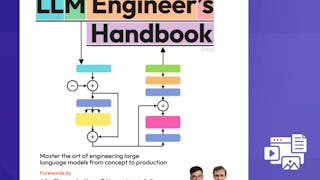This course is designed to guide you through the evolution of natural language processing (NLP), from its historical roots to the cutting-edge advancements of today. You'll delve into the mechanics of modern deep learning architectures, exploring ground breaking concepts like attention and alignment mechanisms. Gain hands-on experience with leading LLMs such as ChatGPT, Llama, and T5, and discover how these models are revolutionizing AI-driven solutions. Through practical lessons, you'll learn about semantic search and build your own retrieval-augmented generation systems. Additionally, you'll gain experience in prompt engineering, enabling you to communicate effectively with LLMs. By the end of this course, you'll be equipped with the skills to effectively leverage the power of LLMs.

Unlock access to 10,000+ courses with Coursera Plus. Start 7-Day free trial.


Quick Start Guide to Large Language Models (LLMs): Unit 1
This course is part of Quick Start Guide to Large Language Models (LLMs) Specialization

Instructor: Pearson
Included with
Recommended experience
What you'll learn
Understand the evolution and mechanics of modern NLP and LLMs.
Build and implement semantic search systems using embeddings.
Master prompt engineering for reliable and consistent LLM outputs.
Create retrieval-augmented generation systems and AI agents.
Skills you'll gain
Details to know

Add to your LinkedIn profile
July 2025
4 assignments
See how employees at top companies are mastering in-demand skills

Build your subject-matter expertise
- Learn new concepts from industry experts
- Gain a foundational understanding of a subject or tool
- Develop job-relevant skills with hands-on projects
- Earn a shareable career certificate

There is 1 module in this course
This course beings with the evolution of modern Natural Language Processing (NLP) and the significant advancements made in this technology over the past few decades. You'll delve into the mechanics of contemporary deep learning architectures, addressing questions such as how machines learn to read and write text and covering the key topics of attention and alignment mechanisms. Next, you'll explore large language models (LLMs) like ChatGPT, Llama, and T5, and learn about their underlying mechanisms. Building on this foundational knowledge, you'll transition to practical applications, such as performing semantic searches across extensive databases and building retrieval augmented generation (RAG) systems using both closed and open-source components. You will also learn how to craft effective prompts for LLMs. The course culminates in your constructing basic RAG systems and developing an AI agent capable of executing multiple tasks sequentially in a natural conversational manner. This module serves as your introduction to the expansive world of LLMs, catering to both beginners and enthusiasts eager to deepen their understanding.
What's included
18 videos4 assignments
Earn a career certificate
Add this credential to your LinkedIn profile, resume, or CV. Share it on social media and in your performance review.
Explore more from Machine Learning
 Status: Free Trial
Status: Free Trial Status: Free Trial
Status: Free Trial
Why people choose Coursera for their career





Open new doors with Coursera Plus
Unlimited access to 10,000+ world-class courses, hands-on projects, and job-ready certificate programs - all included in your subscription
Advance your career with an online degree
Earn a degree from world-class universities - 100% online
Join over 3,400 global companies that choose Coursera for Business
Upskill your employees to excel in the digital economy
Frequently asked questions
Yes, you can preview the first video and view the syllabus before you enroll. You must purchase the course to access content not included in the preview.
If you decide to enroll in the course before the session start date, you will have access to all of the lecture videos and readings for the course. You’ll be able to submit assignments once the session starts.
Once you enroll and your session begins, you will have access to all videos and other resources, including reading items and the course discussion forum. You’ll be able to view and submit practice assessments, and complete required graded assignments to earn a grade and a Course Certificate.
More questions
Financial aid available,



